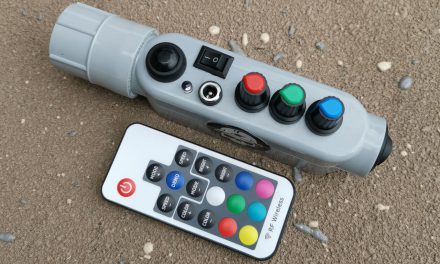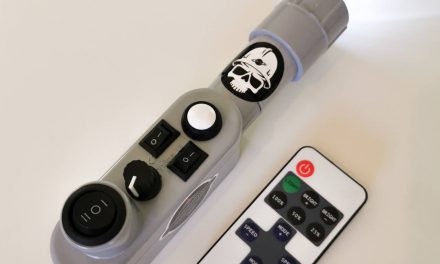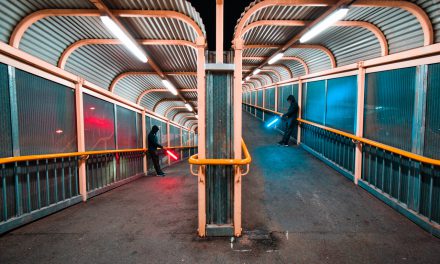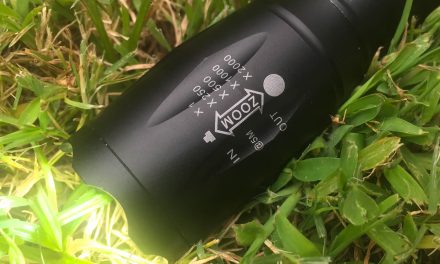
Battery Charger Buying Guide

The third and last of my equipment buying guides looks at battery chargers. Along with buying flashlights and batteries, buying a decent charger can be a minefield for those new to light painting art.
NiMH chargers
NiMH chargers are used to charge rechargeable NiMH AAA, AA, and sometimes C and D batteries. There are two types of NiMH chargers – timer based (dumb) chargers, and smart chargers. Timer based chargers are commonly found for sale in supermarkets, and just run on a timer. This can result in uneven charge, and “cooking” of batteries that have reached full charge, degrading the life span of the battery. Thus I do not advise buying timer based (dumb) chargers. Instead you need to look for smart chargers which terminate charge based on voltage (approx. 1.5V), or better still -dv/dt algorithm. Better NiMH batteries can handle fairly large charge currents (up to 2A for AA Eneloops), though not so good NiMH batteries prefer lower charge currents. As many AAA or AA lights use up to 4 batteries, I would advise looking for 4 slot smart chargers. Good examples are the newer Panasonic BQ-CC55 and older BQ-CC16/17.
For those who need to charge 9V NiMH batteries, options include the Opus BT-C900. For those who would like an NiMH only analysing charger (see next section for further information on analysing chargers) then the Opus BT-C700 and SkyRC NC2600 may be worth a look.
Unless you are sure you are only going to ever use NiMH batteries, then you should consider multi-chemistry chargers that also charge li-ion batteries. These are explained in the next section.
Li-ion and multi-chemistry chargers
There are some dedicated li-ion chargers such as the XTAR MC1 and VP2, and Nitecore F1. However, many li-ion chargers can also charge NiMH and these are known as multi-chemistry chargers. Most li-ion batteries need to be charged to 4.2V using CC/CV algorithm. Smaller li-ion batteries such as 14500 and 18350 typically need to be charged at up to 0.5A, 18650 at 1-1.5V, and 26650 can be charged at 2A. There are also a recent spate of fast chargers than can charge at higher current, but more on that later.
Basic li-ion and multi-chemistry chargers will have a basic indication of charge status (e.g. charging and full). Examples include single slot Klarus K1, dual slot Nitecore i2 and Liitokala Lii-202, and the four slot Nitecore i4. This may be OK if you are on a budget and charging batteries for use in single battery flashlights. However, I prefer to use chargers that display the voltage, or use a digital multi-meter (DMM) to check voltage before and after charge. This increases safety, as you can tell if for example, a battery has been excessively discharged (<2.5V) in a flashlight with no low voltage protection, or if a faulty charger has overcharged a battery. This may question re-use of the battery. Voltage indication can also give you a better idea of how much charge is remaining, for example to make a decision on whether you need to charge a battery before a night of light painting. Thankfully there are plenty of mid-range chargers that show voltage, including the Nitecore SC4 and older D4 (only buy from official Nitecore dealers due to many fakes), GyrFalcon All-44 and 88, and XTAR VC2 and VC4.
Better still are analysing chargers that not only display voltage, but can also measure internal resistance (IR) of the battery, and test battery capacity. This is very useful if you want to keep on eye on how batteries are degrading over time, or looking after matched batteries to be used in multi-battery flashlights. In multi-battery flashlights voltages must be the same, and IR similar before use. This avoids mismatched batteries reverse-charging during use and risk of explosion. Analysing chargers will also show a running total of how much charge (mAh) has been put into the batteries. Budget examples are the Liitokala Lii-500, Opus BT-C3100/3400, and Zanflare C4. Note that these budget models are made to a “price point”, particularly the first two. More expensive analysing chargers include the consumer orientated XTAR DRAGON VP4 Plus (this is what I use) and the hobbyist orientated SkyRC MC3000.
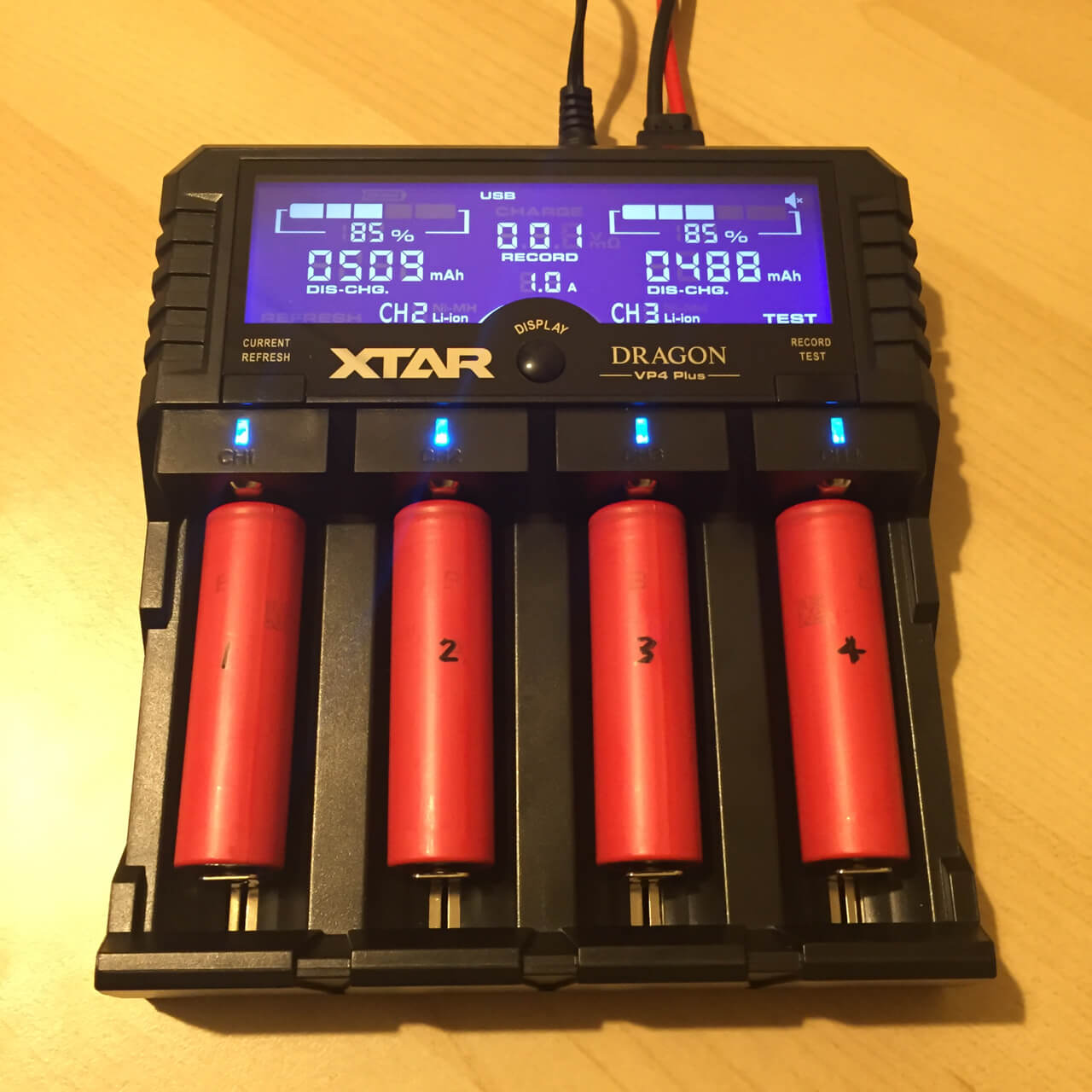
XTAR VP4 Dragon Plus Analysing Charger
Fast chargers
Very fast NiMH chargers such as the Varta LCD Ultra Fast Charger and Duracell CEF15, have been around for many years, with claims of 15 minute charge. Well, they can charge in 15 minutes, but with a severe detriment to battery lifespan. Avoid, unless you like buying replacement batteries! More recently there have been some fast li-ion chargers introduced to the market that can charge up to 4A. The Nitecore SC2’s default charge rate is 2A which may be too higher for older and low drain li-ion batteries. The Miboxer C4-12 and XTAR Over 4 Slim (odd name) can charge up to 3A or 4A per channel respectively, with current based on battery internal resistance. The jury is still out on these new chargers, as even high drain batteries such as the Samsung 30Q have a recommended standard charge rate of 1.5A. These chargers may be useful before a last minute decision to go out light painting, but sometimes it is best to be patient! (At 1A current it will take less than 2 hours to charge a 3500mAh 18650 battery from 50% charge).
Internal flashlight chargers
Some flashlights include internal USB charging. This can be useful if you only have a couple of li-ion flashlights and want to avoid investing in a charger, or if you are out and about (e.g. on vacation) and don’t want to carry a charger around. Internal charging allows for the charging of the li-ion battery inside the light, usually via micro-USB, or a magnetic charging cable. These usually charge at up to 1A, though this can be dependant on the quality of the power supply. Most quality flashlight brands such as Klarus, Olight, and LED Lenser have been tested for correct li-ion charge termination (between 4.15V and 4.2V). Unfortunately, there have been cases with some budget brands where charge termination has been dangerously high, or so low it adversely affects runtime. Best to check reviews on flashlight forums before purchasing. Also be wary that some magnetic charging connections can be easily short circuited (e.g. by steel wool), so take care when storing or transporting these types of lights. Some flashlights with internal charging have various forms of crude % charge indicator (such as red, orange, and green lights), which can be useful to inform as to approximate battery charge status. Due to lack of voltage, IR, and mAh charged display, I’m personally not a fan of internal flashlight chargers, but they are increasingly popular with consumers. In fact, I expect that in a few years time the majority of li-ion flashlights will have internal charging. I would recommend periodically checking battery voltage with a DMM before and after charge to check that the internal charger is working correctly.
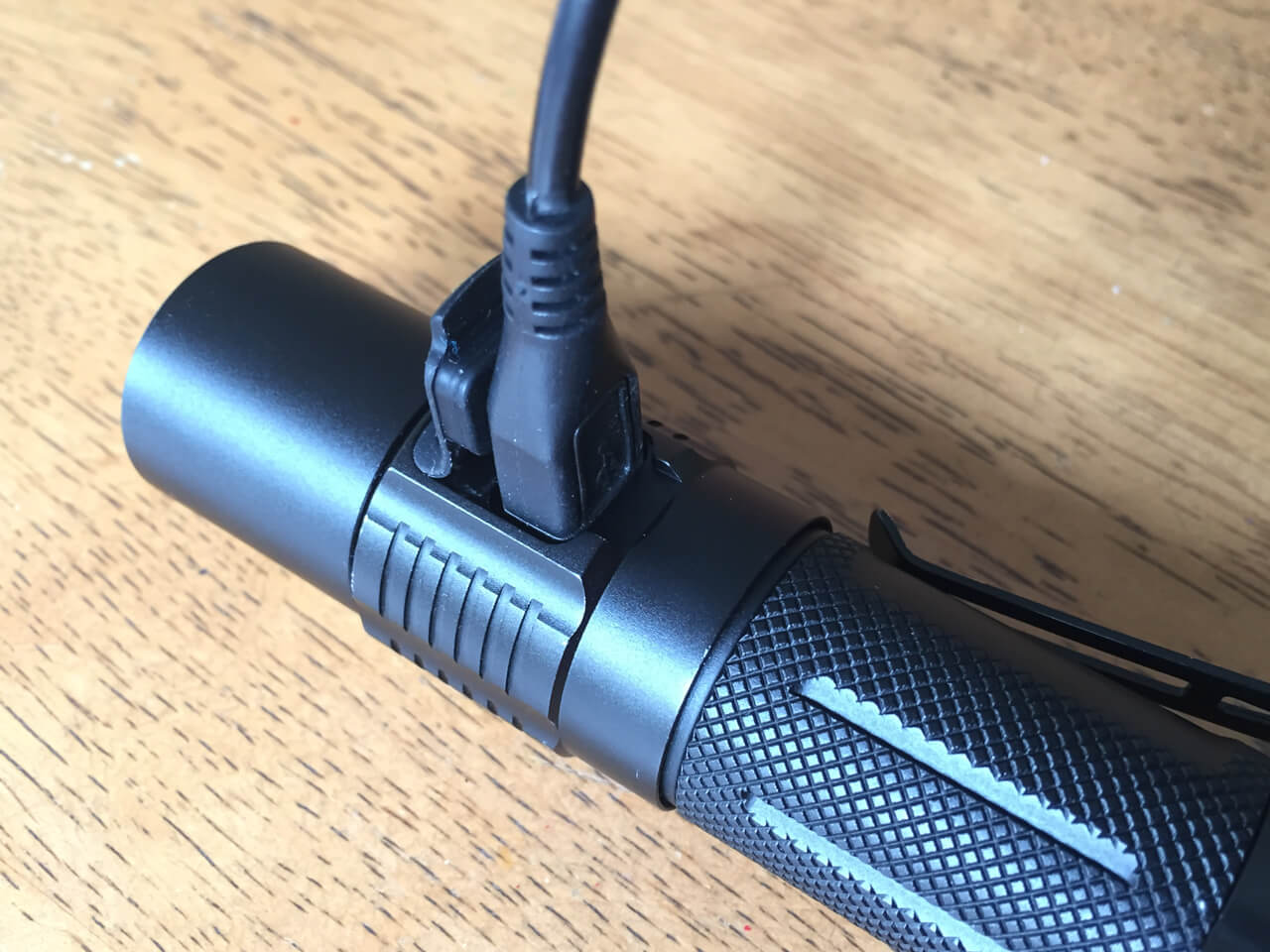
Internal USB Charging on Klarus XT2CR flashlight
Internal battery charging
There are a few li-ion batteries that have a micro-USB charging port. As with internal flashlight charging, these may be useful for people who don’t want to buy a charger. Again, I’m not a fan of these due to lack of voltage and IR testing, and more parts to go wrong. They are also very long, have low charging current, low maximum current, and may not fit in many flashlights. I would only advise using these if they come included with the flashlight, as per the Atactical/Wowtac range of flashlights.
Conclusion
If you only intend on using NiMH batteries, then buy a smart NiMH charger.
If you intend on charging both NiMH and li-ion batteries, then I would recommend a multi-chemistry charger and DMM, or a multi-chemistry analysing charger which displays voltage, charged current (mAh), and IR. For some situations, flashlights with internal charging are useful. However it is best to periodically use a DMM to check the battery voltage before and after charge to make sure it is functioning correctly.
A very trusted source of charger reviews is lygte info.










